Professional Drones: Understanding the Key Differences
When it comes to choosing the right drone for your needs, one of the first decisions to make is whether to go with a mini drone or a professional drone. While both categories of unmanned aerial vehicles (UAVs) are popular among hobbyists and professionals alike, they differ greatly in terms of size, performance, capabilities, legal requirements, and intended use. Here's a detailed comparison to help you determine which type of drone best suits your needs.
1. Size and Weight
Mini drones are designed to be compact, lightweight, and highly portable—perfect for recreational flying, learning to fly, or practicing indoor flights. Weighing under 250g, most mini drones fall below regulatory thresholds, making them exempt from FAA registration, pilot licenses, and liability insurance requirements in the United States.
In contrast, professional drones are larger, often exceeding 250g and sometimes weighing several kilograms, especially when equipped with high-resolution 4K cameras, gimbals, or specialized payloads for surveying, mapping, or aerial photography. Their increased size contributes to greater flight stability, hovering capabilities, and resilience against wind and other environmental factors.
2. Features
Mini drones usually offer basic flight control, headless mode, and RTF (ready-to-fly) configurations, but often lack advanced features such as GPS positioning, collision avoidance, or autonomous flight modes.
Professional drones come equipped with cutting-edge technology: obstacle sensing, follow me mode, autopilot, HD video recording, and real-time telemetry. Many models, such as the DJI Mavic 3, Autel EVO II, or Yuneec Typhoon H, include 3-axis gimbals, brushless motors, gyro stabilization, and foldable designs for portability. These drones often support interchangeable cameras, ND filters, and advanced flight planning software, making them ideal for cinematography, infrastructure inspections, and disaster relief missions.
3. Legal and Regulatory Considerations
Here’s where the distinction becomes critical:
-
Mini drones under 250 grams are generally not subject to FAA Remote ID rules, registration, or licensing.
-
Professional drones (250g and above) require:
-
FAA Part 107 certification to fly for commercial purposes. This includes passing a knowledge test covering airspace classifications, weather, and aeronautical decision-making.
-
Registration with the FAA.
-
A Remote ID broadcasting device (effective since 2023), which allows air traffic control and other UAV operators to monitor drone activity in shared airspace.
-
Liability insurance, especially for commercial applications, search and rescue, or public safety operations.
-
International regulations vary. In the EU, Canada, UK, and Australia, similar thresholds exist, and operators may be required to complete online training, register their aircraft, or acquire permits for autonomous operations.
4. Performance and Battery Life
Mini drones generally offer shorter flight times (5–15 minutes), limited range, and reduced wind resistance. They're ideal for beginners, selfies, or casual flying. They often use lithium polymer (LiPo) batteries with smaller capacities.
Professional drones excel in flight performance. Top models boast:
-
30–60 minute flight durations
-
Multiple autonomous flight modes
-
Redundant flight controllers and GPS+GLONASS navigation
-
Long-range transmission systems, often using OcuSync, enabling live video streaming up to several miles
Their advanced propulsion systems, multi-rotor designs, and payload balancing make them suitable for professional videography, agricultural surveys, and industrial inspections.
5. Camera Quality and Imaging
While some mini drones now include 1080p cameras, their image stabilization and optics are often basic. These camera drones are best for entry-level aerial shots, but not for professional content.
Professional drones often include:
-
4K/6K video cameras, such as those from Hasselblad or Sony Alpha series
-
High megapixel stills, ideal for surveying, photogrammetry, or cinematography
-
Support for HDR, optical zoom, and infrared imaging
-
Integration with microSD cards, gimbals, and autofocus systems
6. Cost
Mini drones are budget-friendly, ranging from $50–$300. They’re ideal for hobbyists, gift buyers, or anyone exploring drones for the first time.
Professional drones can cost anywhere from $500 to $10,000+, depending on specs, camera quality, battery life, and modular features. Additional costs may include:
-
Extra batteries
-
Storage cases or backpacks
-
Propeller guards
-
Charger hubs
-
Software licenses
7. Use Cases
| Mini Drones | Professional Drones |
|---|---|
| Learning to fly | Industrial inspections |
| Indoor flying | Real estate and construction photography |
| Fun and entertainment | Public safety and emergency response |
| Basic aerial photos/videos | Surveying, agriculture, and 3D mapping |
| Drone racing and acrobatics | High-end filmmaking and videography |
Conclusion
Whether you're flying a nano drone in your backyard or piloting a professional quadcopter for a commercial shoot, understanding the core differences between mini and professional drones is crucial. From regulatory compliance and camera capabilities to payload capacity and flight duration, every aspect matters.
With the drone industry rapidly evolving, new models are bridging the gap between fun and function. Always evaluate your goals, budget, and local regulations before making a purchase. Whether you're a hobbyist, content creator, or licensed commercial pilot, there's a drone on the market to meet your needs and take your vision airborne.



